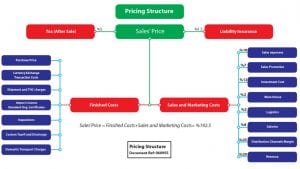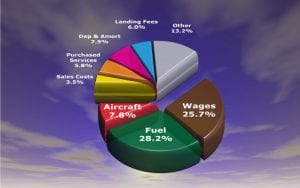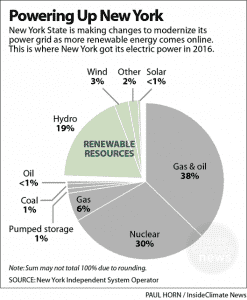
How To Create A Good Pricing Structure In 5 Easy Steps 👣
A major development in Australian business recently is re-designing a more sophisticated pricing structure to collect more revenue across different customer and price segments without losing volume or margin.
The reason why more companies are choosing to re-design their price structures now (more than ever) is because markets are changing. Additionally, old cost-plus pricing structures are leaking margin and capping revenue potential because they are not providing enough price flexibility.
>Download Now: Free PDF A Capability Framework for Pricing Teams
For example, in the past 5 years; and especially since COVID, Australian businesses have been experiencing intense pricing pressure and need more flexibility in their price structures. However, many existing pricing structures are riddled with pricing errors and the cost-plus price-setting logic applied in structure is just too broad and simplistic. In short, many price structures are awash with multiple price points for many items. Also, they have limited fences or tiers to distinguish the value of products within categories.
In this article, we will explain what a pricing structure is and how a good pricing structure can dramatically help your sales teams improve pricing decisions in the following ways:
- Real-world industry examples, including different types of pricing structure in B2C airline flight ticket prices, electricity/energy and B2B industrial.
- A detailed checklist and tips on how to develop a sophisticated pricing structure for your business that takes into account industry nuances.
- An evaluation of pricing department structure and team role requirements for strategic pricing work like pricing structure redesign.
We will argue that a messy illogical price structure is a business’ greatest source of margin erosion because:
- B2B procurement teams are focusing on price inconsistencies.
- How people consume and buy products and service is changing rapidly as a result of wide-scale industry disruption and technological advancement.
- Sales teams are losing confidence in pricing structures because they find them complicated, hard to understand or misaligned to market expectations.
- Markets and business models are changing quickly and fixed, cost-plus pricing is struggling to unlock the pricing power of transformation projects.
By the end of this article, you will learn what a price structure is and how to re-design your price structure to drive profitability and stop margin leakage.
Table of Contents:
I. What is a Pricing Structure?
II. How to Create a Pricing Structure
III. How Positioning can Affect your Pricing Structure for Services
What is a Pricing Structure?
A price structure is a construct which organises a business’ product prices across multiple brands and categories. It’s the backbone or structure of a firms price-category hierarchy. What’s more, it is the price mechanism that enables a business to execute a pricing strategy at all levels – business, brand, category, product and SKU level.
A distinguishing feature of a good price structure is price point relativity – or the logical spacing of price points relative to other price points. Quite often in a price structure, various products are interrelated – the same logic applies to price points for SKUs (Stock Keeping Units). This means all SKU price points should be ranked and grouped correctly using a pricing rule i.e., each price point should be logically related and positioned correctly relative to other price points within an associative product hierarchy.
The interrelationships between SKU prices is called price relativity as mentioned above. In a good price structure, they’ll be strong statistical interrelationships between SKUs which in turn will indicate price and product grouping. What’s more, each price point should be calculated and positioned logically within its category and in relation to other items in the overall price structure.
Interrelationships between SKU prices in a given price structure should be organised around an anchor product in the overall product category. The anchor product is the keystone product or the architype in the product category. The architype product is the reference point for price setting within a given product category – it sets the price level for the category and price points for related SKUs.
A sophisticated pricing structure varies not just the price but also adjusts the offer or the criteria to qualify for it.
Applying pricing rules and criteria (discussed above) to a price structure, then is based on price rules and logic i.e., price relativity (as explained above), price fences, tiers and detailed price data analytics. Fences, for example, are another important aspect of a price structure because they ensure a business doesn’t cannibalise their own products and brands. Also, fences and tiers help a business demarcate price levels across categories; and in turn help analysts to match the right price point with the right product.
Price tiers are another important way of organising your pricing structure correctly. Price tiers enable a business to order their products and prices and even customer groups to a good, better best pricing structure. Both fences and tiers are important for optimisation and segmentation purposes. Without fences and tiers, pricing quickly becomes a mess and price points are random, scattered; creating a huge amount of pricing complexity.
Prior to 2005, most businesses didn’t really have a robust pricing structure.
Even to the present day, many companies operate without a robust pricing structure and list price strategy in place. We would estimate that:
- Around 60% of corporate pricing structures do not have logical price relativities between SKU prices or product categories.
- Over 70% of product hierarchies are too flat (i.e., 1 or two tiers)
- And over 50 – 70% of price data architectures in leading corporations are largely unusable or incompatible with price optimisation software.
More often than not, businesses without a well thought through pricing structures lose margin by excessively discounting or crudely enforced cost-plus pricing. SKU prices are commonly all over the place and/or many sales teams prefer to negotiate different prices for the same line item (i.e., interactive pricing or haggle price) rather than organise their prices into a good pricing structure.
For example, it is not uncommon for sales teams to distrust their existing price lists and pricing structures and ‘go off list’ to set customer invoice prices themselves – otherwise known as discretion pricing.

Many businesses still believe a pricing structure restricts their ability to adjust prices
There is a common misconception that a pricing structure doesn’t give sales teams the flexibility they need to negotiate prices with customers. This is not really the case at all. A segmented or tiered pricing structure is a great way for sales teams to charge different prices to different customers and for different amounts without over-charging or underselling an item or bundle.
Different types of pricing structures
Airlines pricing teams have long employed a segmented price structure similar to a hotel pricing structure. A segmented pricing structure enables airlines to maximise the revenue they can earn from different customers based on capacity utilisation and yield management.
The pricing structure for an industrial equipment and engineering company, conversely, derives much of its revenue from winning bids and tenders and renewing high-value and volume contracts.
In this last instance, the pricing structure analysis process would cover off areas such as:
- discounting
- rebates mechanisms
- go to market strategies
- won-loss sales
- and tracking distribution centres and branches

Fuels, commodities, rental car, tourism, retail, and even some industrial supplies and heavy machinery businesses (like John Deere, Hilti and Caterpillar) have for a long time now used a segmented pricing structure for their “value-add” services as well as traditional product portfolios.
A key benefit of a segmented price structure is that it encourages customers to pay a price aligned with the value (perceived value) different customer groups place on a product or service using concepts such as value at use and value at risk concepts.
Electricity markets pricing structure and economics explained
Wholesale electricity pricing structures are another interesting example of pricing structures redesign. Typically, an electricity pricing structure is designed around complex cost structures. Things like their cost of operations, including the fuels used by power plants to meet the demand for electricity. However, another important fence typically applied in most electricity businesses’ pricing structure is time. A time fence in a price structure is used by electricity businesses to encourage customers to buy in off-peak hours or when the business needs to balance or utilise capacity or prevent outages.
However, because most energy operations still exist within a system-wide wholesale market, price signals tend to be aggregated and pricing is still fundamentally fixed. This often limits price-setting because customer invoice pricing tends to be fixed too with only off-peak pricing exceptions.
In the past couple of years, however, there has been a wide-scale disruption in the electricity market and the concept of optimising based on demand is being scientifically tested and trialled. In New York City, for example, local government and private business are working with consultants to design a smarter market. These changes are also changing perceptions of value in the energy market and more importantly, willingness to pay and price setting practices.
New York authorities are developing a new system, called “The Grid”. This new system will completely change current electricity pricing structures and revenue models, including how people perceive the value of energy.
The “Grid” will integrate the state’s increasing number of distributed energy sources into a dynamic centralised operational system. It will include wholesale energy and alternative sources.
Sources such as:
- power plants (wholesale market)
- sources solar rooftops
- battery storage
- household generators
- and virtual storage (renewable energy sources)
Together these power systems will constitute resources that can be used to help the state’s electric power system accommodate the swings in demand and supply that are part of the natural daily and seasonal cycle.
B2C Electricity pricing structure will be dynamic
It’s only a question of time, then, before all electricity pricing structures are highly dynamic and focused on the needs and values of consumers (value-based pricing).
A major driver for introducing dynamic pricing in the electricity and fuels market is that the cost to produce energy is decreasing. The cost of production will decrease even more with streamlined production and consistent into a dynamic, centralised grid. It will not be commercially viable for authorities and private businesses to set customer pricing based on their costs anymore. The reason is, their cost positions will be too low and they won’t make enough margin.
The implication of the new grid system for pricing structure development
A centralised grid system will inevitably enable pricing and operations teams to identify more revenue and margin opportunities and operational inefficiencies than ever before:
- There will be significant supply efficiencies even in remote areas that are difficult to supply. Also, in metro areas that experience frequent “brownouts”.
- Electricity wholesalers will massively decrease their operational costs.
- Government and pricing teams will be able to monitor individual consumption of energy.
- Private business will find supplying energy to remote areas more appealing. This is because they’ll receive more money (not less) for doing so.
- Teams will have localised data to read pricing signals occurring across the grid in real-time.
- Authorities and private business will be able to rapidly identify price realisation opportunities that are typically obscured by a system-wide wholesale market and aggregate data.
- Pricing structures will include regional capacity metrics allowing more granular customer-focused pricing.
〉〉〉 Get Your FREE Pricing Audit 〉〉〉
And, of course, people will finally get the cleaner energy they want and even in remote locations.


How to Create a Pricing Structure
Re-designing a pricing structure for complex markets, like the energies example discussed above will involve complex pricing work.
A segmented electricity pricing structure (like the one discussed above) has a vast array of price-offer configurations, price metric and fences. Each will be appropriate for addressing different reasons for the existence of value-based segments.
Below listed are just a few key steps and tips you’ll need to consider as you’re re-creating a segmented, value-based pricing structure for services or products:
1. Understand how to create value for different customer segments
- Do this by estimating how much value different combinations of benefits could represent to customers (pricing structure analysis). Then, test your assumptions and estimates with your customers (marketing survey, customer value discovery, sales CRM, won-loss stats).
- Then, identify differences in the potential contribution that can be captured from different customers segments.
- Consider which price, performance-based and tie-in metrics are relevant for your business and industry.
- (Remember: Value received is sometimes not even related to differences in the quantity of the product bought. Research shows metrics tend to align most with how buyers experience. ‘Value In Use” and “Value at Risk”, rather than features and benefits).
2. Develop appropriate price and buyer fences
- Think about fences in your pricing structure as fixed criteria customers must meet to qualify for a lower price/offer.
- Use appropriately: purchase time fences, purchase quantity fences as discount tactics (i.e., volume discounts, order discounts, step discounts, two-part prices).
- Remember: You’ll need fences in your price structure to allow you to charge different customers different price levels for the same products and services using the same metrics. Fences actually give your pricing structure flexibility and sophistication (even though the term ‘fence’ suggests rigidity and restrictions).
- Test different offers or options for select customer groups
3. Check if your pricing structure is commercially viable
- Choose low-risk customer segments (i.e., price trials, test, customer value discovery exercises, simulations). Make adjustments to your price and customer segmentation, as required based on the findings from your trials and tests.
- Analyse whether the “additional offer combination” costs more to administer than the incremental profit it would generate. Pay attention to differences in cost-to-serve. Is it easy to measure and enforce? Can you generate favourable positioning versus the competition with a tiered pricing structure?
- Capture the best possible price from each segment; making the sales at the lowest possible cost, or both. Re-align with your customers’ price response: direct feedback, sensitivity analyses and won-loss stats.
- Refine price-offer structure for different segments (generally, customers are self-selective; if they don’t tell you what they want, they’ll certainly tell you what they don’t want.).
4. Strategically unbundle value when necessary
- For other segments, strategically unbundle value if a bundle in a particular segment is undermining rather than enhancing profits. To do this, determine the right offer and price for the offer based on detailed competitive and customer intelligence.
- Then configure a new price-offer structure and test like crazy.
- Remember: Leave room for customers to customise their own offers and which features and services to bundle into packages. As you refine and add to your pricing structure, consider many different configurations to customise your price structure.
5. Make sure the features and services align with the market and customer base
- The end goal here is to evaluate bundling alternatives versus unbundled products and services.
- What makes the most money?
- Is it practical?
- Is it benefiting your customer base?
Implications
If you’re not sure how to build a pricing structure, consider appointing a pricing manager to help you. Price structure development or redesign is not easy. It’s a highly technical piece of work and requires a depth of pricing expertise.
But remember, if you go down this path, pricing management roles are wide and varied in their remit. Senior commercial pricing executives, for instance, tend to have great change management and strategy development skills. Some pricing team job descriptions, conversely, are more technical like architect roles. The job descriptions are more suitable to the price structure re-design work.
〉〉〉 Get Your FREE Pricing Audit 〉〉〉
Conclusion
In this article, we discussed creating a pricing structure that aligns with your differentiates (i.e., the value generated) versus your cost structures. We discussed how the principles of pricing structures can serve as a guide to driving optimal revenues across segments.
Price structure development is one of the most important pricing activities to improve profitability done by a world-class pricing team. While designing an optimal pricing structure for services and products seems difficult. But it’s also potentially the most rewarding aspect of pricing strategy.
For companies launching offers with differentiated benefits, you’ll need a new pricing structure.
For firms employing a business model with changing operations and different cost structures; you’ll need to re-design your pricing structure to accommodate change and capitalise on new revenue opportunities.
You need to think carefully about who you hire to do this type of detailed pricing work. Pricing structure development is not something anyone can do. The process of developing a pricing structure requires a depth of pricing expertise. Hire pricing managers and analysts with the right traits, such as lateral and vertical thinking capability.

How Positioning Can Affect Your Pricing Structure For Services
Pricing for professional service firms can be difficult, especially when you’re fighting for clients. Difficult situations or disruptions, such as the coronavirus pandemic, can throw you off and leave your business misaligned with your intended positioning. If you have found yourself in this situation, you may be working with clients you should never have taken on in the first place. This article will be focusing on how to align your business to create a solid pricing structure for services.
Business positioning is a term used to describe where your business stands against other players in the industry. This is a way for your business to establish a unique identity and fill a particular market’s need. A well-positioned business can help you remain distinguishable and resilient when markets get tough.
If proper business positioning hasn’t been on the top of your to-do list, now is the time to start. You don’t want to end up with a weak client and market profile, as well as a swath of internal conflicts that arise due to clients you may be unfit to handle.
Likewise, it will be impossible to create a solid pricing structure for services without proper positioning and identity. Building a strategy framework starts with finding your firm’s identity and challenges first.
Professional firms can run into a number of challenges without clear client mixes, especially because typical corporate top-down approaches don’t work for this format. Service firms generally evolve pretty quickly, so it’s the professional’s job to deliver consistent skill and value.
However, clients can also greatly affect a professional’s growth and experience. So, it’s imperative that you choose to take on the right clients for your skillset along with the skills you want to develop.
Levels of Practices
There are several levels of practices your firm may fall under. This is crucial to understand in order to position yourself properly and create an effective pricing structure for services. Keep in mind that these aren’t clear cut, and some firms can span more than one of these categories. However, these serve as foundations for understanding your position.
Positioning can be shifted as needed since firms and client profiles are subject to change over time. Economic environments can also be a major influencer of where your firm sits at any given time.
Routine
Routine practices mainly specialise in, as the name suggests, routine problems. These can usually be dealt with through economical and quick services that have a low margin of error. Firms that handle routine practices usually have lower costs and margins, yet higher leverage.
Complex Procedure
Complex procedure practices typically deal with more complicated problems. Projects typically have several parts, and while these aren’t the most high-profile cases, they require a much more systematic approach than the routine level. Costs are still relatively low, with moderate to high leverage.
Expert
Expert practices require professionals with a lot more experience than the previous two levels. These issues are quite major and require years of expertise dealing with similar issues, as clients typically have none. Margins and costs are higher, with moderate leverage.
Deep Expertise
Deep expertise practices handle the big guns, so to speak. These firms deal with large company issues such as mergers or acquisitions. This requires years of experience, the most updated theory, plus the ability to creatively problem-solve unique and complex issues. Clients pay high prices for these firms’ ability to develop innovative solutions, and leverage is low.
Elements of a Pricing Structure For Services
Professional services generally use this formula for their pricing structures with adjustments based on their type of practice:
Profitability = Margin x Rate x Utilization x Leverage
Your margin includes profit divided by revenue. Rate equals your revenue divided by the time billed. Utilisation is your time billed divided by the number of professionals involved. While leverage is the number of professionals divided by the number of partners.
Deep expertise and expert practices use 50% margins, while complex practices use 35 to 50%, and routine levels use 20 to 35%.
Leverage is low for an expert to deep expertise practices because senior professionals have to be at the forefront of cases, while professionals in routine practices can easily pass cases on to junior professionals, therefore leverage is high.
Implications of Incorrect Positioning on Your Pricing Structure for Services
As we have mentioned, taking on clients despite their mismatch to your skills and practice can lead to a whole lot more problems down the line. These clients might expect you to carry out a different type of practice, creating pressure and confusion.
This can also create a misunderstanding of value, giving your firm difficulties when the time comes to collect payments. Unclear positioning can give clients a vague perception of what your services are worth, which is hard to correct.
Incorrect positioning can often come from desperation for new clients, which leads to firms taking on clients that should be seeking lower level practices. It can also come from misplaced arrogance, which leads to firms taking on cases that should be going to higher-level practices.
Importance of Correct Positioning on Your Pricing Structure for Services
The importance of proper positioning is that you understand what your professionals are capable of, as well as which clients will benefit your business the most. This will increase your value and clarify perceptions of how you are valued.
By doing so, you can leverage pricing properly, and not be short-changed for your services. The ability to command value is key to thriving as a professional service firm, no matter what the situation is.
As your firm evolves, you’ll also need to adapt your positioning. Understanding the different levels of firms can help you recognise when you need to rethink your positioning or your client profile.
〉〉〉 Get Your FREE Pricing Audit 〉〉〉
Bottomline
In conclusion, positioning is vital to understand when creating your pricing structure for services. Professional firms can leverage correct positioning to their advantage, thereby allowing them to price their services correctly.
As firms understand their positioning as a practice, they can choose clients that will help them grow as a business. In uncertain times, businesses must invest in strategies that can help them remain competitive and resilient.
For a comprehensive view on building a great pricing team to prevent loss in revenue,
Download a complimentary whitepaper on How to Build Hiring Capability To Get The Best Pricing Team.
Are you a business in need of help to align your pricing strategy, people, and operations to deliver an immediate impact on profit?
If so, please call (+61) 2 9000 1115.
You can also email us at team@taylorwells.com.au if you have any further questions.
Make your pricing world-class!
Related Posts
2 Comments
Leave a Reply Cancel reply
Categories
- marketing strategy (26)
- Organisational Design (14)
- Podcast (114)
- Pricing Capability (87)
- Pricing Career Advice (10)
- Pricing Recruitment (19)
- Pricing Strategy (289)
- Pricing Team Skills (13)
- Pricing Teams & Culture (24)
- Pricing Transformation (47)
- Revenue Model (25)
- Sales Effectiveness (27)
- Talent Management (7)
- Technical Pricing Skills (35)








Great blog post! As a business owner, I completely understand the importance of having a well-thought-out pricing structure. It can make or break your business, especially in a competitive market. I appreciate the insights on how to differentiate between value-based and cost-based pricing, and how to use psychological pricing to influence customer decisions. Will definitely be implementing some of these strategies in my own business. Thanks for sharing!
Great blog post! As a business owner, I completely agree that pricing structure is crucial for making profitable decisions. It’s so easy to get caught up in the quest for higher sales numbers that we forget to consider the true cost of our products or services. Your breakdown of the different pricing strategies was incredibly helpful in understanding how to approach pricing in a more strategic way. Thanks for sharing!